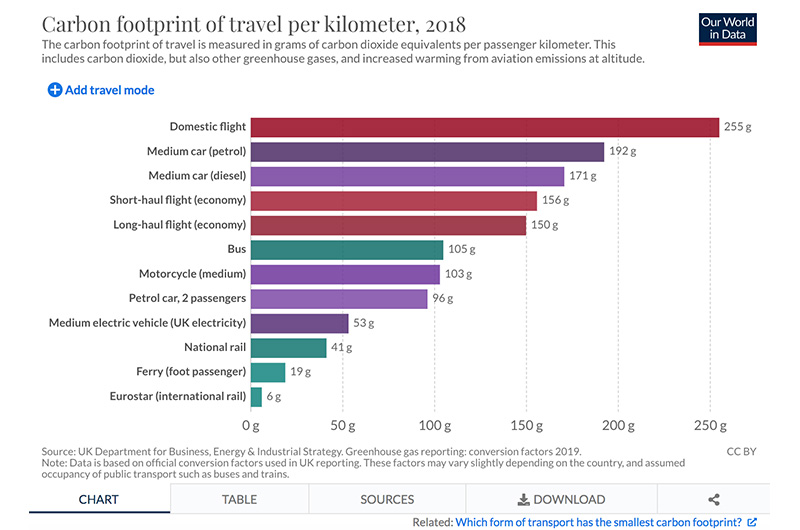Skift Take
Severe drought and record-setting heat waves in western North America serve as a clear reminder of the urgent need to maintain sustainability as an event priority and step-up your event sustainability strategy. Here’s what you need to do.
We can all agree that climate change is a serious issue, but as the event industry comes out of the pandemic crisis, it is tempting to get back to planning familiar in-person events at all costs. However, with hybrid formats emerging and new business models being explored, now is the perfect time to bake sustainability into your larger event strategy.
Pre-pandemic event sustainability strategies focussed on reducing disposables, reusing decor and recycling. But how effective are these steps at actually reducing carbon emissions that contribute to climate change? And will they meet the needs of an increasing number of organizations that are making net-zero carbon footprint commitments?
As of June 2021, 733 cities, 31 regions, 3,067 businesses, 173 big investors, and 622 higher education institutions have committed to achieve net zero carbon emissions by 2050 through the Race to Zero Campaign.
Feel intimidated by the challenge? Don’t. We get that you have other priorities and that this is unfamiliar territory, but the task is easier than you’d think.
You don’t need a degree in carbon accounting to figure out what to do. In fact, there are a number of free do-it-yourself (DIY) tools for learning how to make impactful sustainability changes to your event program.
Here’s what you need to do.
Start Measuring
The carbon footprint of events can vary widely. For example, the footprint of the Fall 2019 Meeting of the American Geophysical Union was estimated at three tonnes of carbon dioxide equivalent emissions per participant. In contrast, the 14th Congress of the European Association of Agricultural Economists was estimated at half a tonne per participant.
These examples underline how every event–even among event types that seem similar–is unique. So before taking action, measure. And if you are comparing your footprint using per participant metrics, understand that it is best to measure progress against yourself.
There are a variety of free tools to help you calculate the carbon impact of an event.
The Myclimate Event Carbon Calculator is one of many free online calculators that event organizers can use to estimate emissions for an event that is held live and in person. To effectively use a DIY calculator like this, planners will need to have the following information:
- Number of attendees
- Number of attendee trips
- Size of the venue
- Number of hotel stays
- Type and quantity of food served
- Amount of event freight
- Types of materials used and discarded onsite
Interested to learn more about carbon impacts associated with specific event decisions? Calculators exist for many facets of events:
- Freight: The EcoTransIT calculator offers comparative data for truck, train, air and sea logistics.
- Hotels: The Hotel Footprinting Tool estimates the emissions impact of hotel stays anywhere in the world.
- Catering: The BBC offers a simple food calculator comparing the climate impact of 34 different food and beverage items.
Once the total emissions footprint of an event is determined and establishes a benchmark, use the following questions to determine where to cut down:
- What are the major sources of emissions and what are the most effective ways to reduce them?
TIP: Create a pie chart of total emissions showing the relative impact of different logistics. The largest portions of the event “carbon pie” (typically transportation) should be addressed first.
- How does the footprint compare to previous events?
TIP: Divide the total emissions by the number of participants to compare emissions intensity from event to event. If the number exhibits a downward trend, the event is becoming more carbon-efficient.
Set a Target
Assuming the event is recurring, an appropriate next step would be to set a carbon reduction target. But what should the target be?
In the absence of an event industry-wide emissions target, the SME Climate Hub recommends companies work to:
- Halve greenhouse gas emissions before 2030
- Achieve net zero emissions before 2050
- Disclose progress on a yearly basis
Bear in mind these targets are for company activities broadly, of which events are a part. However, because events typically generate a sizable amount of business travel, they often stand out as having a notable responsibility to reduce. So while a 50% reduction by 2030 may seem ambitious, it is also likely necessary in order to stay within the carbon budget stipulated under the Paris Agreement.
Note that SME Climate Hub stresses the need for an absolute reduction, meaning the total emissions for an event should drop by half by 2030. Why not per participant emissions, you may ask? While lower per participant emissions are a sign of improved efficiency–signifying a reduction in carbon intensity–they can also hide an increase in total emissions in certain situations. So tracking both is ideal, and targets to reduce total emissions are what is most important.
Maximize More Sustainable Formats
With potential carbon reductions of 67% to 89%, hybrid events are greener, so sustainability is another reason to double down on virtual engagement. If your event is pursuing hybrid strategies, the Digital Event Carbon Calculator can be used to estimate the footprint of content that is streamed. It requires basic data about the duration of the event and number of participants in the virtual environment.
Tackle Transport
But of course onsite events are coming back so, for your onsite component, here’s how to tackle what is likely the biggest contributor to your event footprint: transportation.
Reducing flights and shifting trips to lower-impact modes of travel such as rail is typically the best way to reduce emissions for in-person events, as illustrated by the footprint of different modes of transport below (Our World in Data).
Credits: Our World in Data
Interested in establishing a climate-friendly policy for business travel for your event company? Stay Grounded offers a helpful guide, including tips on using decision trees to evaluate the necessity of trips as well as ideas to create conditions that make it attractive for travellers to opt for more sustainable choices when coming to your event.
Measure the impact of your travel policy by using the ICAO Air Travel Calculator. If you’re adapting to use more rail transport in Europe you can also compare the environmental savings of train trips using the EcoPassenger tool.
IN CONCLUSION
Sustainability expectations have evolved during the pandemic, and event professionals can dig deeper in order to show measurable results by not just assuming “green” best practices help, but actually proving how event designs reduce emissions in quantifiable ways. By being proactive to learn how to measure and reduce emissions now, event organizers will be better prepared to adapt to the additional disruptions brought on by the climate realities of tomorrow.






